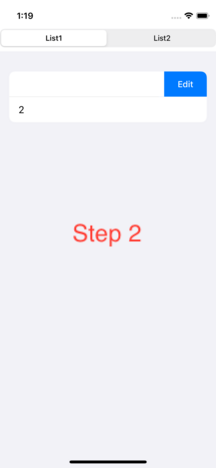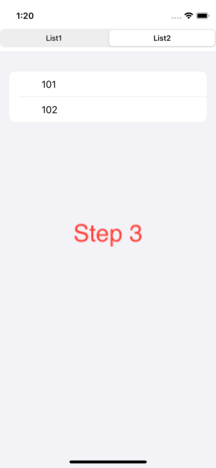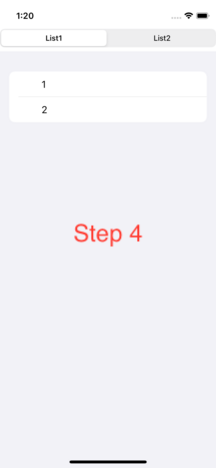The issue can be reproduced consistently with the code below. Xcode 13.3 + iOS 15.4 (both are latest).
enum ListID: String, CaseIterable, Hashable, Identifiable {
case list1 = "List1"
case list2 = "List2"
var id: Self {
self
}
}
struct ContentView: View {
@State var listID: ListID = .list1
var body: some View {
VStack {
// 1) Picker
Picker(selection: $listID) {
ForEach(ListID.allCases) { id in
Text(id.rawValue)
}
} label: {
Text("Select a list")
}
.pickerStyle(.segmented)
// 2) List
switch listID {
case .list1:
createList(Array(1...2), id: .list1)
case .list2:
createList(Array(101...102), id: .list2)
}
}
}
@ViewBuilder func createList(_ itemValues: [Int], id: ListID) -> some View {
List {
ForEach(itemValues, id:\.self) { value in
Text("\(value)")
.swipeActions(edge: .trailing, allowsFullSwipe: false) {
Button("Edit") {
// do nothing
}
.tint(.blue)
}
}
}
.id(id)
}
}
Steps to reproduce the issue:
- start up the app. See picture 1.
- swipe item 1 in list 1, keep the "Edit" button untouched (don't click on it). See picture 2
- then select list 2 in the picker. You should see there is an extra space before the items in the list. What's more, all list items are not swipable any more. See picture 3.
- then select list 1 in the picker. It has the same issue. See picture 4.
The issue is not specific to picker. For example, it can be reproduced if we replace picker with a set of buttons. I believe the issue occurs only if the old list is destroyed in SwiftUI view hierarchy. From my understanding of structured identity in SwiftUI, list 1 and list 2 are considered separate views in SwiftUI view hiearch. So it's not clear how they could affect each other. The only reason I can guess is that, while list 1 and list 2 are considered separate virtual views, SwiftUI actually use the same physical view for them (e.g., for performance purpose, etc.). So it seems a SwiftUI bug to me.
Thinking along that line, I can work round the issue by not destroying lists:
ZStack {
createList(Array(1...2), id: .list1)
.opacity(listID == .list1 ? 1 : 0)
createList(Array(101...102), id: .list2)
.opacity(listID == .list2 ? 1 : 0)
}
This works perfectly in this specific example, but unfortunately it's not scalable. For example, in my calendar app when user clicks on a date in the calendar, I'd like to show a list of events on the date (I'd like to use different list for different date. I do so by calling id() to set different id to each list). There isn't an obvious/elegant way to apply the above work around in this case.
So I wonder if anyone knows how to work around the issue in a more general way? Thanks.




